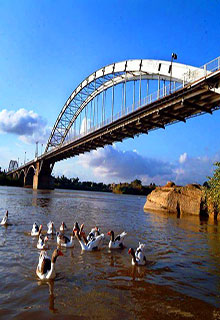Ahvaz
A city in the southwest of Iran and the capital of Khuzestan province. It is home to Persians, Arabs, Lurs (Bakhtiaris), Dezfulis, Shushtaris, which is called Ahvaz.
Also, different languages are spoken in it. Population of this city is about 1,300,000 and its built-up area with the nearby town of Sheybani is home to 1,136,989 inhabitants. Iran's only navigable river, the Karun, passes by the middle of the city.

Description
This city is situated on both banks of the Kārūn River where it crosses a low range of sandstone hills. The town has been identified with Achaemenid Tareiana, a river crossing on the royal road connecting Susa, Persepolis, and Pasargadae. Ardashīr I, the Sāsānian king (224–241 CE) who rebuilt the town, named it Hormuzd Ardashīr. He dammed the river, providing irrigation water, and the town prospered.
The discovery of oil in Khuzestan in the 20th century brought new prosperity to Ahvaz. Because of its location near the border with Iraq, it was heavily bombarded during the Iran-Iraq War (1980–88). Nonetheless, a steel complex west of the town began operating in 1989. This city is at a junction of two branches of the Trans-Iranian Railway. It is also connected with Abadan, Khorramshahr, Shushtar, Dezful, and the oil fields by road and with Tehrān by air. Shahid Chamran University (1955; formerly Jundi Shapūr University) is located there.
History
It has a long history dating back to the Achaemenid period. In the ancient times, it had been one of the main centers of the Academy of Gondishapur. Some believe that it is the city of Aginis referred to in Greek sources. The founder of the Sassanid Dynasty Ardashir I (180-242 CE) rebuilt the city on both sides of the river, designating one half for God and the other half for himself and naming it Hormoz-Ardashir. In the Sassanid era (224–651 CE) the city became a center for textile production and a trade hub.
By the time of the Arab attack, half of the city was inhabited by nobles and named Hormshir and the other half was inhabited by merchants and called Hujestan-vacar (market of Khuzestan). After the Arab attack only the market half of the city remained intact.
In the early Islamic era, the city flourished as a market town and became known as Souq al-Ahvaz (Market). However, the city fell into ruin in the course of centuries of conflict and endless power struggles.